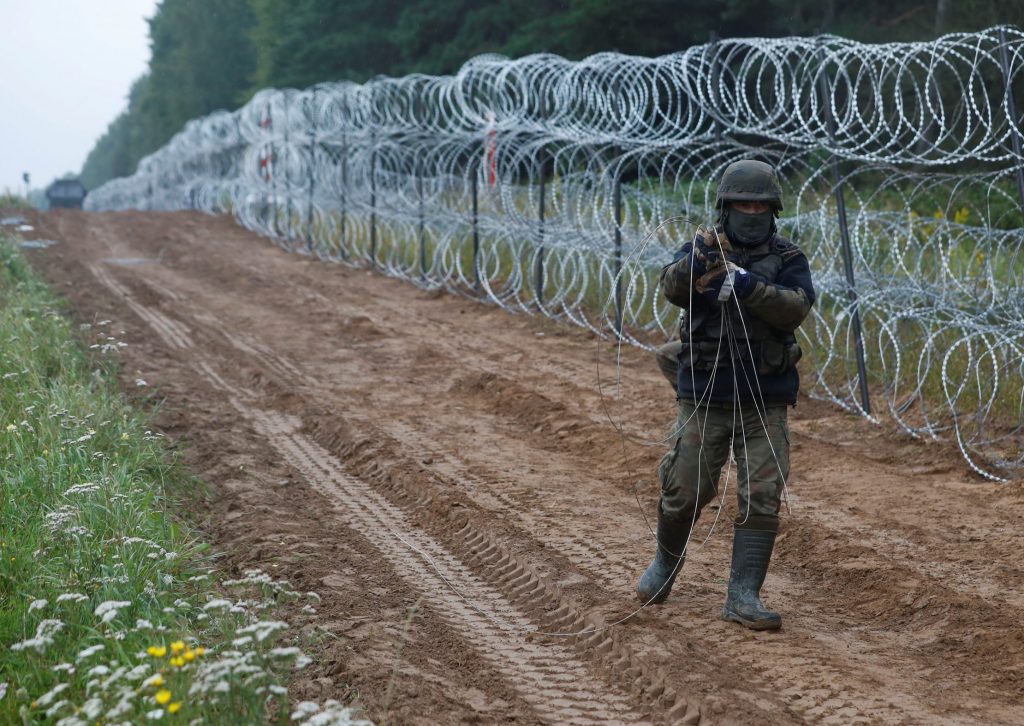Alyaksandr Lukashenka chose a telling location last week to announce that Belarus would soon receive an enormous military hardware consignment from Russia.
Speaking in the eastern Belarusian city of Babruysk on September 1, the autocratic leader said Russia would be sending combat jets, helicopters, and air defense missile systems, possibly including S-400 missile systems, “in the near future.”
The significance of making such an announcement in Babruysk should be clear to anybody who has been following the cat-and-mouse game that has been Russian-Belarusian relations in recent years. Since 2013, Kremlin leader Vladimir Putin has been trying to strongarm Lukashenka into allowing a new Russian airbase in that city, and Lukashenka had long been resisting.
That is, apparently, until recently. Back in March 2021, Lukashenka indicated that he was prepared to drop his long-standing opposition to the base in Babruysk, which would host SU-27 fighter jets flown by Russian pilots. The city is already the site of a Belarusian air base.
Lukashenka’s announcement about a large new Russian military consignment was just the latest data point in a pattern indicating the intensifying militarization of Belarus and accelerating integration of the Russian and Belarusian armed forces.
On the day Lukashenka spoke, Russian anti-aircraft missile troops were arriving in the western Belarusian city of Hrodna, near the border with Poland and Lithuania, to set up a joint military training center. Days later, a shipment of SU-30SM fighter jets arrived at an airbase in Baranovichi, also in western Belarus. And from September 10-16, the massive joint Russian-Belarusian Zapad-2021 military exercises are scheduled to take place.
Moreover, the Zapad-2021 exercises follow a record number of joint military exercises between the two countries this year, with the constant rotation of Russian forces amounting to a de facto permanent Russian troop presence in Belarus.
The escalating militarization of Belarus and the expanding Russian military footprint inside the country represent the most significant qualitative change in the security equation on NATO’s Eastern flank since Moscow’s 2014 annexation of Crimea and armed intervention in Ukraine’s Donbas region.
This trend directly threatens the security of Latvia, Lithuania, and Poland. It also enhances Moscow’s ability to close the Suwalki Gap, a roughly 100-kilometer stretch of the Polish-Lithuanian border wedged between Belarus and Russia’s heavily militarized Kaliningrad region, which would effectively cut the Baltic states off from the rest of NATO.
It may be too early to talk about the return of a divided Europe, but with Belarus increasingly resembling an extension of Russia’s Western Military District, things certainly do appear to be heading in that direction.
Adding to the Iron Curtain vibe, Poland, Lithuania, and Latvia have recently begun constructing barbed wire fences on their borders with Belarus in response to a crisis Lukashenka has manufactured by importing migrants from across the Middle East to Minsk and then facilitating their illegal entry into Europe.
Poland’s parliament voted on September 6 to uphold a state of emergency declared by President Andrzej Duda along the country’s eastern border with Belarus. Citing the illegal migrant crisis, the Zapad-2021 exercises, and the increased militarization of Belarus, Prime Minister Mateusz Morawiecki stated that “in Moscow and Minsk scenarios are being written” that threaten Poland’s security and sovereignty.
Eurasia Center events

Russia’s creeping military domination of its far smaller western neighbor also makes the long-term project of Belarus’s deeper political and economic integration less urgent.
Lukashenka is scheduled to travel to Moscow on September 9, on the eve of the Zapad exercises, for what will be his fifth meeting with Putin this year. The two are expected to go through the motions of signing a package of so-called integration “roadmaps.”
But the Belarusian political analyst Artem Shraibman noted in a recent commentary, “on the Russian side, there is clearly less enthusiasm” for the formal integration process than was the case in 2019. Shraibman added that there are “faster methods” for keeping Belarus tightly inside Russia’s orbit, including the new military facility in Hrodna, “and Moscow is actively using them.”
In other words, Russia simply doesn’t need to annex Belarus in a spectacular Crimea-style operation. And it no longer needs to bully Lukashenka into deeper integration.
The Putin regime is already achieving its geopolitical goals in Belarus by leveraging Lukashenka’s isolation and vulnerability to steadily establish military facts on the ground. Belarus is now a Russian military platform and the West needs to adapt to this reality to protect frontline NATO states.
A new Iron Curtain could indeed be descending on Europe. It may not be on the same scale as the continent-wide barrier of the Cold War era, but it nevertheless has major implications for European security and the confrontation with Putin’s Russia.
Brian Whitmore is a Nonresident Senior Fellow at the Atlantic Council’s Eurasia Center, an Assistant Professor of Practice at the University of Texas at Arlington, and host of The Power Vertical Podcast.
Further reading
The views expressed in UkraineAlert are solely those of the authors and do not necessarily reflect the views of the Atlantic Council, its staff, or its supporters.

The Eurasia Center’s mission is to enhance transatlantic cooperation in promoting stability, democratic values and prosperity in Eurasia, from Eastern Europe and Turkey in the West to the Caucasus, Russia and Central Asia in the East.
Follow us on social media
and support our work
Image: A Polish soldier engaged in the construction of a new security barrier on the country's eastern border with Belarus as part of Poland's response to Belarus dictator Alyaksandr Lukashenka's weaponization of illegal migration into the EU. August 26, 2021. (REUTERS/Kacper Pempel)




